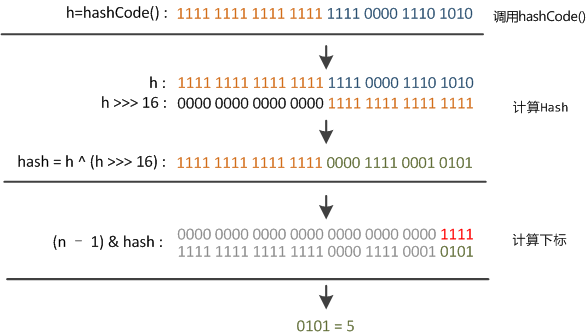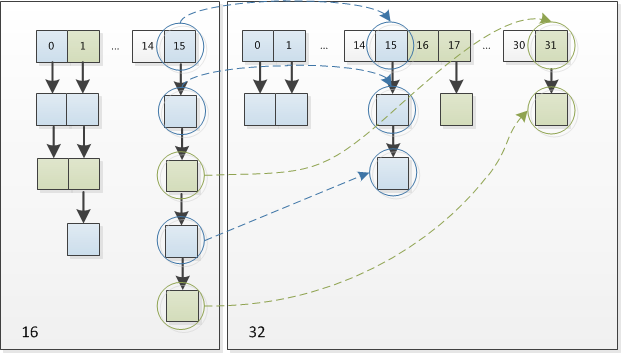Table of Contents
1. 两个重要的参数
容量(Capacity)和负载因子(Load factor)
- Initial capacity: The capacity is the number of buckets in the hash table, The initial capacity is simply the capacity at the time the hash table is created.
- Load factor: The load factor is a measure of how full the hash table is allowed to get before its capacity is automatically increased
简单的说,Capacity就是bucket的大小,Load factor就是bucket填满程度的最大比例。如果对迭代性能要求很高的话不要把capacity设置过大,也不要把load factor设置过小。当bucket中的entries的数目大于capacity*load_factor时就需要调整bucket的大小为当前的2倍。
2. put函数的实现
put函数大致的思路为:
- 对key的hashCode()做hash,然后再计算index;
- 如果没碰撞直接放到bucket里;
- 如果碰撞了,以链表的形式存在bucket后;
- 如果碰撞导致链表过长(大于等于TREEIFY_THRESHOLD),就把链表转换成红黑树;
- 如果节点已经存在就替换old value(保证key的唯一性)
- 如果bucket满了(超过load factor*current capacity),就要resize
具体代码:
public V put(K key, V value) {
// 对key的hashCode()做hash
return putVal(hash(key), key, value, false, true);
}
final V putVal(int hash, K key, V value, boolean onlyIfAbsent,
boolean evict) {
Node<K,V>[] tab; Node<K,V> p; int n, i;
// tab为空则创建
if ((tab = table) == null || (n = tab.length) == 0)
n = (tab = resize()).length;
// 计算index,并对null做处理
if ((p = tab[i = (n - 1) & hash]) == null)
tab[i] = newNode(hash, key, value, null);
else {
Node<K,V> e; K k;
// 节点存在
if (p.hash == hash &&
((k = p.key) == key || (key != null && key.equals(k))))
e = p;
// 该链为树
else if (p instanceof TreeNode)
e = ((TreeNode<K,V>)p).putTreeVal(this, tab, hash, key, value);
// 该链为链表
else {
for (int binCount = 0; ; ++binCount) {
if ((e = p.next) == null) {
p.next = newNode(hash, key, value, null);
if (binCount >= TREEIFY_THRESHOLD - 1) // 转成红黑树
treeifyBin(tab, hash);
break;
}
if (e.hash == hash &&
((k = e.key) == key || (key != null && key.equals(k))))
break;
p = e;
}
}
// 写入
if (e != null) { // existing mapping for key
V oldValue = e.value;
if (!onlyIfAbsent || oldValue == null)
e.value = value;
afterNodeAccess(e);
return oldValue;
}
}
++modCount;
// 超过load factor*current capacity,resize
if (++size > threshold)
resize();
afterNodeInsertion(evict);
return null;
}
3. get函数的实现
get的大致思路:
- bucket里的第一个节点,直接命中;
- 如果有冲突,则通过key.equals(k)去查找对应的entry。若为树,则在树中通过key.equals(k)查找,O(logn);若为链表,则在链表中通过key.equals(k)查找,O(n)。
具体代码:
public V get(Object key) {
Node<K,V> e;
return (e = getNode(hash(key), key)) == null ? null : e.value;
}
final Node<K,V> getNode(int hash, Object key) {
Node<K,V>[] tab; Node<K,V> first, e; int n; K k;
if ((tab = table) != null && (n = tab.length) > 0 &&
(first = tab[(n - 1) & hash]) != null) {
// 直接命中
if (first.hash == hash && // always check first node
((k = first.key) == key || (key != null && key.equals(k))))
return first;
// 未命中
if ((e = first.next) != null) {
// 在树中get
if (first instanceof TreeNode)
return ((TreeNode<K,V>)first).getTreeNode(hash, key);
// 在链表中get
do {
if (e.hash == hash &&
((k = e.key) == key || (key != null && key.equals(k))))
return e;
} while ((e = e.next) != null);
}
}
return null;
}
4. hash函数的实现
在get和put的过程中,计算下标时,先对hashCode进行hash操作,然后再通过hash值进一步计算下标,如下图所示:

在对hashCode()计算hash时具体实现是这样的:
static final int hash(Object key) {
int h;
return (key == null) ? 0 : (h = key.hashCode()) ^ (h >>> 16);
}
可以看到这个函数大概的作用就是:高16bit不变,低16bit和高16bit做了一个异或。其中代码注释是这样写的:
Computes key.hashCode() and spreads (XORs) higher bits of hash to lower. Because the table uses power-of-two masking, sets of hashes that vary only in bits above the current mask will always collide. (Among known examples are sets of Float keys holding consecutive whole numbers in small tables.) So we apply a transform that spreads the impact of higher bits downward. There is a tradeoff between speed, utility, and quality of bit-spreading. Because many common sets of hashes are already reasonably distributed (so don’t benefit from spreading), and because we use trees to handle large sets of collisions in bins, we just XOR some shifted bits in the cheapest possible way to reduce systematic lossage, as well as to incorporate impact of the highest bits that would otherwise never be used in index calculations because of table bounds.
在设计hash函数时,因为目前的table长度n为2的幂,而计算下标时,(n - 1) & hash,设计者认为这方法很容易发生碰撞。为什么这么说呢?不妨思考一下,在n-1=15(0x1111)时,其实散列真正生效的只是低4bit的有效位,当然容易碰撞了。
因此,设计者想了一个顾全大局的方法(综合考虑了速度、作用、质量),就是把高16bit和低16bit异或了一下。设计者还解释到因为现在大多数的hashCode的分布已经很不错了,就算是发生了碰撞也用O(logn)的tree去做了。仅仅异或一下,既减少了系统的开销,也不会造成的因为高位没有参与下标的计算(table长度比较小时),从而引起的碰撞。
如果还是产生了频繁的碰撞,会发生什么问题呢?作者注释说,他们使用树来处理频繁的碰撞。
在Java8之前的实现中是用链表解决冲突的,在产生碰撞的情况下,进行get时,两步的时间复杂度是O(1)+O(n)。因此,当碰撞很厉害的时候n很大,O(n)的速度显然是影响速度的。因此在Java8中,利用红黑树替换链表,这样复杂度就变成了O(1)+O(logn)了,这样在n很大的时候,能够比较理想的解决这个问题。
5. RESIZE的实现
当put时,如果发现目前的bucket占用程度已经超过了Load Factor所希望的比例,那么就会发生resize。在resize的过程,简单的说就是把bucket扩充为2倍,之后重新计算index,把节点再放到新的bucket中。
当超过限制的时候会resize,然而又因为我们使用的是2次幂的扩展(指长度扩为原来2倍),所以,元素的位置要么是在原位置,要么是在原位置再移动2次幂的位置。
例如我们从16扩展为32时,具体的变化如下所示:

因此元素在重新计算hash之后,因为n变为2倍,那么n-1的mask范围在高位多1bit(红色),因此新的index就会发生这样的变化:

因此,我们在扩充HashMap的时候,不需要重新计算hash,只需要看看原来的hash值新增的那个bit是1还是0就好了,是0的话索引没变,是1的话索引变成“原索引+oldCap”。可以看看下图为16扩充为32的resize示意图:

这个设计确实非常的巧妙,既省去了重新计算hash值的时间,而且同时,由于新增的1bit是0还是1可以认为是随机的,因此resize的过程,均匀的把之前的冲突的节点分散到新的bucket了。
具体实现:
final Node<K,V>[] resize() {
Node<K,V>[] oldTab = table;
int oldCap = (oldTab == null) ? 0 : oldTab.length;
int oldThr = threshold;
int newCap, newThr = 0;
if (oldCap > 0) {
// 超过最大值就不再扩充了,就只好随你碰撞去吧
if (oldCap >= MAXIMUM_CAPACITY) {
threshold = Integer.MAX_VALUE;
return oldTab;
}
// 没超过最大值,就扩充为原来的2倍
else if ((newCap = oldCap << 1) < MAXIMUM_CAPACITY &&
oldCap >= DEFAULT_INITIAL_CAPACITY)
newThr = oldThr << 1; // double threshold
}
else if (oldThr > 0) // initial capacity was placed in threshold
newCap = oldThr;
else { // zero initial threshold signifies using defaults
newCap = DEFAULT_INITIAL_CAPACITY;
newThr = (int)(DEFAULT_LOAD_FACTOR * DEFAULT_INITIAL_CAPACITY);
}
// 计算新的resize上限
if (newThr == 0) {
float ft = (float)newCap * loadFactor;
newThr = (newCap < MAXIMUM_CAPACITY && ft < (float)MAXIMUM_CAPACITY ?
(int)ft : Integer.MAX_VALUE);
}
threshold = newThr;
@SuppressWarnings({"rawtypes","unchecked"})
Node<K,V>[] newTab = (Node<K,V>[])new Node[newCap];
table = newTab;
if (oldTab != null) {
// 把每个bucket都移动到新的buckets中
for (int j = 0; j < oldCap; ++j) {
Node<K,V> e;
if ((e = oldTab[j]) != null) {
oldTab[j] = null;
if (e.next == null)
newTab[e.hash & (newCap - 1)] = e;
else if (e instanceof TreeNode)
((TreeNode<K,V>)e).split(this, newTab, j, oldCap);
else { // preserve order
Node<K,V> loHead = null, loTail = null;
Node<K,V> hiHead = null, hiTail = null;
Node<K,V> next;
do {
next = e.next;
// 原索引
if ((e.hash & oldCap) == 0) {
if (loTail == null)
loHead = e;
else
loTail.next = e;
loTail = e;
}
// 原索引+oldCap
else {
if (hiTail == null)
hiHead = e;
else
hiTail.next = e;
hiTail = e;
}
} while ((e = next) != null);
// 原索引放到bucket里
if (loTail != null) {
loTail.next = null;
newTab[j] = loHead;
}
// 原索引+oldCap放到bucket里
if (hiTail != null) {
hiTail.next = null;
newTab[j + oldCap] = hiHead;
}
}
}
}
}
return newTab;
}
6. 总结
HashMap的工作原理:
通过hash的方法,通过put和get存储和获取对象。存储对象时,我们将K/V传给put方法时,它调用hashCode计算hash从而得到bucket位置,进一步存储,HashMap会根据当前bucket的占用情况自动调整容量(超过Load Facotr则resize为原来的2倍)。获取对象时,我们将K传给get,它调用hashCode计算hash从而得到bucket位置,并进一步调用equals()方法确定键值对。如果发生碰撞的时候,Hashmap通过链表将产生碰撞冲突的元素组织起来,在Java 8中,如果一个bucket中碰撞冲突的元素超过某个限制(默认是8),则使用红黑树来替换链表,从而提高速度。
get和put的原理:
通过对key的hashCode()进行hashing,并计算下标( n-1 & hash),从而获得buckets的位置。如果产生碰撞,则利用key.equals()方法去链表或树中去查找对应的节点
hash的实现:
在Java 1.8的实现中,是通过hashCode()的高16位异或低16位实现的:(h = k.hashCode()) ^ (h >>> 16),主要是从速度、功效、质量来考虑的,这么做可以在bucket的n比较小的时候,也能保证考虑到高低bit都参与到hash的计算中,同时不会有太大的开销。
7. LinkedHashMap
LinkedHashMap是Hash表和链表的实现,并且依靠着双向链表保证了迭代顺序是插入的顺序。
Hash table and linked list implementation of the Map interface, with predictable iteration order. This implementation differs from HashMap in that it maintains a doubly-linked list running through all of its entries. This linked list defines the iteration ordering, which is normally the order in which keys were inserted into the map (insertion-order).
三个重点实现的函数
void afterNodeAccess(Node<K,V> p) { }
void afterNodeInsertion(boolean evict) { }
void afterNodeRemoval(Node<K,V> p) { }
上面3个函数都是为了保证双向链表中的节点次序或者双向链表容量所做的一些额外的事情,目的就是保持双向链表中节点的顺序要从eldest到youngest。
8. TreeMap
HashMap不保证数据有序,LinkedHashMap保证数据可以保持插入顺序,而如果我们希望Map可以保持key的大小顺序的时候,我们就需要利用TreeMap。put操作时,如果key存在的话,old value被替换;如果不存在的话,则新添一个节点,然后对做红黑树的平衡操作。
successor后继
TreeMap是如何保证其迭代输出是有序的呢?其实从宏观上来讲,就相当于树的中序遍历(LDR)。
for(Entry<Integer, String> entry : tmap.entrySet()) {
System.out.println(entry.getKey() + ": " + entry.getValue());
}
for(Iterator<Map.Entry<String, String>> it = tmap.entrySet().iterator() ; tmap.hasNext(); ) {
Entry<Integer, String> entry = it.next();
System.out.println(entry.getKey() + ": " + entry.getValue());
}
在it.next()的调用中会使用nextEntry调用successor,进行中序遍历。